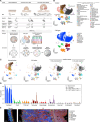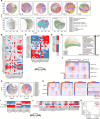This is a preprint.
Spatially defined multicellular functional units in colorectal cancer revealed from single cell and spatial transcriptomics
- PMID: 40667258
- PMCID: PMC12262820
- DOI: 10.1101/2022.10.02.508492
Spatially defined multicellular functional units in colorectal cancer revealed from single cell and spatial transcriptomics
Abstract
While advances in single cell genomics have helped to chart the cellular components of tumor ecosystems, it has been more challenging to characterize their specific spatial organization and functional interactions. Here, we combine single cell RNA-seq, spatial transcriptomics by Slide-seq, and in situ multiplex RNA analysis, to create a detailed spatial map of healthy and dysplastic colon cellular ecosystems and their association with disease progression. We profiled inducible genetic CRC mouse models that recapitulate key features of human CRC, assigned cell types and epithelial expression programs to spatial tissue locations in tumors, and computationally used them to identify the regional features spanning different cells in the same spatial niche. We find that tumors were organized in cellular neighborhoods, each with a distinct composition of cell subtypes, expression programs, and local cellular interactions. Comparing to scRNA-seq and Slide-seq data from human CRC, we find that both cell composition and layout features were conserved between the species, with mouse neighborhoods correlating with malignancy and clinical outcome in human patient tumors, highlighting the relevance of our findings to human disease. Our work offers a comprehensive framework that is applicable across various tissues, tumors, and disease conditions, with tools for the extrapolation of findings from experimental mouse models to human diseases.
Conflict of interest statement
A.M. has served a consultant/advisory role for Third Rock Ventures, Asher Biotherapeutics, Abata Therapeutics, ManaT Bio, Flare Therapeutics, venBio Partners, BioNTech, Rheos Medicines and Checkmate Pharmaceuticals, is currently a part-time Entrepreneur in Residence at Third Rock Ventures, is an equity holder in ManaT Bio, Asher Biotherapeutics and Abata Therapeutics, and has received research funding support from Bristol-Myers Squibb. G.M.B. has sponsored research agreements with InterVenn Biosciences, Palleon Pharmaceuticals, Olink Proteomics, and Teiko Bio. G.M.B. is a consultant for Ankyra Therapeutics and InterVenn Bio. G.M.B. has been on scientific advisory boards for Merck, Iovance, Nektar Therapeutics, Instil Bio, and Ankyra Therapeutics. G.M.B. holds equity in Ankyra Therapeutics. J.L. and M.R. hold equity in 10xGenomics. N.H. holds equity in BioNTech and is a founder of Related Sciences/DangerBio. F.C. is a founder and holds equity in Curio Biosciences. O.Y. holds equity and is a SAB member of AVA Lifesciences. A.R. and O.R.-R. are co-inventors on patent applications filed by the Broad Institute for inventions related to single cell genomics. O.R.-R. has given numerous lectures on the subject of single cell genomics to a wide variety of audiences and in some cases, has received remuneration to cover time and costs. O.R.-R. is an employee of Genentech since October 19, 2020 and has equity in Roche. A.R. is a co-founder and equity holder of Celsius Therapeutics, an equity holder in Immunitas, and was an SAB member of ThermoFisher Scientific, Syros Pharmaceuticals, Neogene Therapeutics and Asimov until July 31, 2020. From August 1, 2020, A.R. is an employee of Genentech and has equity in Roche.
Figures





References
Publication types
Grants and funding
- R21 CA256414/CA/NCI NIH HHS/United States
- U19 MH114821/MH/NIMH NIH HHS/United States
- U24 CA180922/CA/NCI NIH HHS/United States
- R00 CA259511/CA/NCI NIH HHS/United States
- RC2 DK114784/DK/NIDDK NIH HHS/United States
- R01 CA256530/CA/NCI NIH HHS/United States
- R01 CA208756/CA/NCI NIH HHS/United States
- R01 CA244359/CA/NCI NIH HHS/United States
- R01 CA257523/CA/NCI NIH HHS/United States
- R41 EB032693/EB/NIBIB NIH HHS/United States
- R01 CA254108/CA/NCI NIH HHS/United States
- R37 CA259363/CA/NCI NIH HHS/United States
- R21 DK125911/DK/NIDDK NIH HHS/United States
- RM1 HG006193/HG/NHGRI NIH HHS/United States
LinkOut - more resources
Full Text Sources
